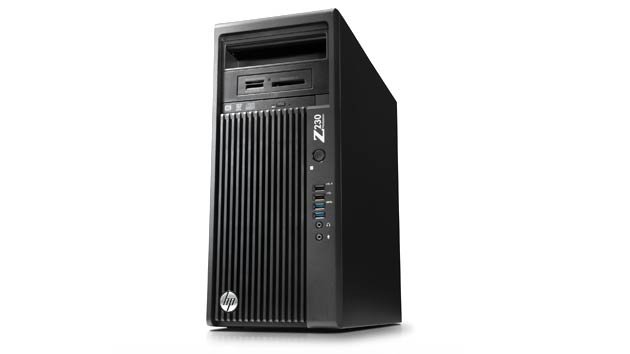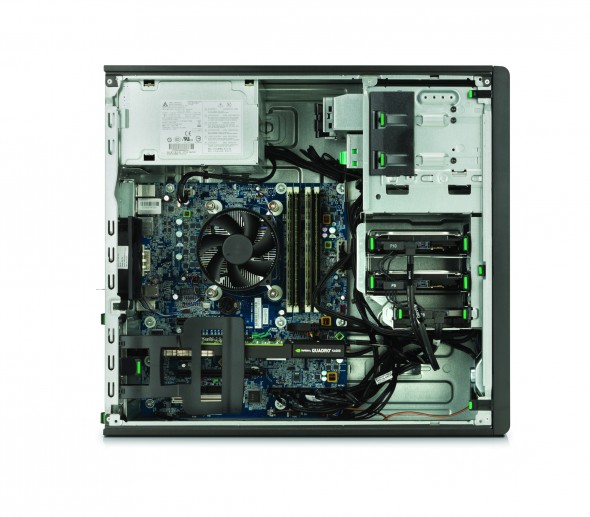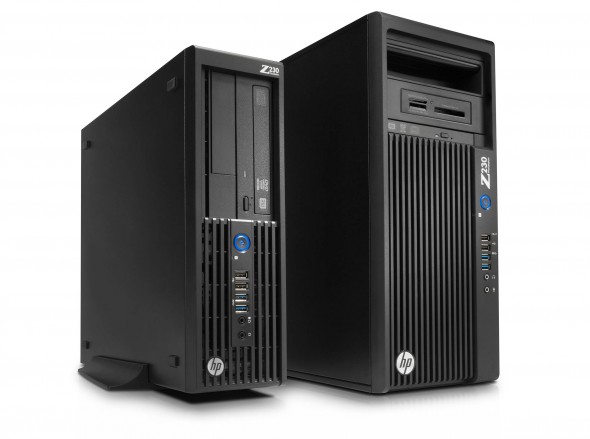Can a Workstation Be Both Affordable and Expandable?
Choosing the right workstation can be tricky, especially for digital media. In theory, you want the fastest model that’s available. In reality, you have to consider cost (well-equipped workstations aren’t cheap), expandability (it should be able to grow along with your future needs), and size (some models aren’t very cubicle friendly). If your focus is on audio, as well as video, you may need to determine beforehand how loud the system will be when it’s configured with a sufficiently powerful graphics card.
The key factor is usually the type of work you’ll be doing. If you work with unusually large or complex projects that would benefit from multiple processor cores and massive amounts of memory, you should consider a high-end workstation, such as an HP Z820 or equivalent. On the other hand, if your projects are more moderate in size and complexity—and you’re under tight budget restraints—you may be better off with an entry-level workstation, such as an HP Z230.
The HP Z230 workstation is a redesign of the Z220, and it’s surprisingly powerful for the price. You can configure a dual-core system (minus the monitor) for less than $1,000. Quad-core configurations are available for less than $1,300. It can be a real bargain—though you’ll want to be sure that it matches your workload and expansion requirements.
If the Shoe Fits
HP has a broad selection of PC-based tower workstations. In between the Z230 and Z820, you’ll find the Z420 and Z620. All four models are ISV certified for professional applications such as Adobe Premiere Pro and Maya. The differences are mostly a matter of price, expandability, and size. You can add as much as 32 gigabytes of memory and 9 terabytes of onboard storage to the Z230. That’s impressive, but it pales in comparison to the Z820, which maxes out at 512GB of memory and 15TB of onboard storage. If you know you’ll never need more than 32GB of memory and 9TB of storage over the life of the system, the Z230 might be the more sensible choice.
Similarly, with processors and graphics cards, the Z230 can be well-equipped for digital media, though not nearly as well-equipped as the Z820. As an entry-level workstation, the Z230 occupies the space between the high-end consumer desktops and the moderate-priced workstations. The processor choices for the Z230 reflect that transitional position. You can go for an Intel fourth-generation Haswell processor (Core i5 or Core i7). Those processors are usually associated with high-end consumer desktops. Or you can go with a current-generation workstation-class Intel Xeon processor.
The Core i5 and Core i7 processors for the Z230 do have some advanced features that you don’t typically find with consumer desktops, such as support for ECC memory. And even though the Z230 is limited to the E3 series Xeon processors (as opposed to the E5 series with the higher-priced HP models), the E3 clock speeds go all the way up to 3.6GHz with four hyper-threading cores.
That’s also impressive, though far short of the Xeon processors that are available for the Z820. There you can pair the dual processor sockets with the highest performance processors to achieve as many as 24 hyper-threading cores. It would cost you a small fortune to equip your system that way, but you can do it.
Pushing Pixels
The system that HP provided for this review had a Xeon E3-1245v processor, which runs at 3.4GHz. It’s just two notches down from the fastest processor available for the Z230—the 3.6GHz E3-1280v processor. Though only slightly faster, the E3-1280v sells for an additional $650 over the E3-1245v. The E3-1245v would be a good choice for the Z230 if you want a fast system, but don’t want to pay substantially more for only a marginal performance boost.
With graphics, the Z230 can range from using the integrated Intel HD graphics all the way to an NVIDIA Quadro K4000 with 3GB of GDDR5 GPU memory. The review system had a Quadro K2000 with 2GB of GDDR5 GPU memory. It’s a sensible choice because it runs roughly as fast as the previous-generation Quadro 4000, but costs about the same as the previous-generation Quadro 2000. It also draws only 80 watts (when active) versus 122 watts for the Quadro K5000 and 142 watts for the previous-generation Quadro 4000. Fewer watts means less cooling, and that translates into a quieter system. Based on its solid performance and low wattage, you could argue that the Quadro K2000 is the current sweet spot for entry-level graphics workstations.
The K2000 currently adds $574 to the price of a Z230 versus the $0 cost for using the integrated graphics. If you want go to for the higher-performance K4000, you should expect the price to be $800-$1,000. The Z820 can go all the way up to the NVIDIA Quadro K6000 or AMD FirePro W7000 cards. As you would expect, the graphics capabilities, price, and power requirements would rise accordingly.
It’s a similar situation with memory. The Z230 supports dual-channel memory, where the Z820 supports quad-channel memory that runs significantly faster. And while you can install half a terabyte of system RAM into a Z820, if you were to price such a configuration, you would quickly find out why 32GB isn’t that limiting, in practical terms, for an entry- to mid-level workstation.
The number of drive bays for the Z230 also isn’t likely to be an issue, unless you’re working extensively with 4K video. The tower configuration (reviewed here) has six drive bays: two internal 3.5-inch, one internal 2.5-inch, two external 5.25-inch, and one slim-line ODD.
Big on the Inside
Compared with the Z220, the Z230 is more compact. It measures 15.7-inches high, 6.7-inches wide, and 17.4-inches deep, where the Z220 was 17.6-inches high, 7.0-inches wide, and 17.9-inches deep. That could be a plus for environments where you can’t use a full-size tower workstation. The Z230 is also available in a SFF (small form factor) version that’s even smaller. It measures just 13.3-inch high, 3.95-inches wide, and 15.1-inches deep.
The SFF is slightly less expensive than the tower version, though there are significant compromises due to the smaller chassis. It has four expansion card slots, as opposed to the five slots in the tower version. And in those four slots, you’ll have to use half-height cards rather than standard full-height cards. Because of the card height, there are restrictions on the graphics cards you can use with the SFF model. You’ll lose one of the internal 3.5-inch drive bays, as well as one of the external 5.25-inch drive bays. And the power supply drops from 400 watts to 240 watts. (In case you’re wondering, the Z820 can have either an 850 or 1,125 watt power supply). On the bright side, the processor and RAM options are the identical for both the tower and SFF versions of the Z230.
While I didn’t have a chance to try the SFF, it would be worth considering if you’re tight for space. Given that you’ll save only $30 by going with the SFF version versus the tower, there’s no real reason to choose it, apart than the smaller size.
Speed Zone
Workstation performance can depend on many things. Chief among them are the speed of the processor, the number of processor cores, and the speed of the graphics subsystem. When evaluating the Z230 in the review configuration, it performed slightly better on some tests than the Z820 I reviewed for StudioDaily back in 2012. That particular Z820 cost more than twice as much and had 16 core processors. So why did the Z230 perform so well by comparison? The Z820 processor had a clock speed of 2.2GHz versus the 3.4GHz processor speed for the Z230. And the Z230 was running the latest Kepler series of graphics cards, which pack more punch for the price. With the 64-bit version of Cinebench 11.5, the Z230 racked up a speedy 60.09fps on the Open GL test. That narrowly beat the 58.07fps from the two-year-old Z820 review system, which was using the older Quadro 4000. (Of course, you can now order a Z820 with the newer Kepler series cards).
The Z230’s Cinebench CPU score was 7.77 points versus 16.74 points for the older Z820. Here you can see the limitations of a 4-core system versus a 16-core system, even if the clock speed on the 16-core system is much slower. A 7.77 point score is still reasonably fast and should be more than adequate for most digital media tasks. Cinebench is an excellent benchmark for evaluating graphics rendering. It’s available for free online, so you could run it on your current system to determine how your workstation might compare with this particular Z230 configuration.
With PCMark Vantage, the Z230 also turned in a very respectable score. This benchmark is designed to test a PC’s ability to work with photos, video, and music, as well as tasks related to games, communications, productivity, and security. Like Cinebench, PCMark Vantage is available in a free version. Interestingly, the Z230’s score of 16,525 was only slightly behind the 17,453 score from the older Z820. Again, the newer-generation Kepler graphics card and faster clock speed helped to make up for some of the other differences between the two workstations.
Do-It-Yourself Upgrades
While it would be misleading to draw any concrete conclusions by comparing an older Z820 configuration with a newer Z230 configuration, it does indicate that the Z230 can be configured to compete with mid-range and even high-end models, depending on the components you choose. That’s important to keep in mind because the Z230—like the other HP Z-class workstations—is easy to upgrade.
The tool-less chassis lets you replace any component yourself. You can add or swap out the hard drives, optical drives, expansion cards, or system memory. Even the processor can be upgraded, though I was told by an HP representative that very few owners actually swap out the processor (it’s probably not that cost effective versus buying a newer model). HP has manuals available online that can help you identify and service the internal parts. This could allow you to buy a low-priced configuration and add memory and drives as needed.
If you’re acquainted with the other Z-workstation models, the Z230 will seem familiar—just smaller with fewer bays and slots. The tower model is 17 percent smaller in volume than the previous Z220. It’s small enough now to be 4U rack mountable. You can open the case with one hand by pulling a release lever on the side panel. Once inside, you’ll see green levers that release the subsystem covers that you remove to reveal the individual components. It’s all very modular and requires no technical expertise to replace or upgrade the components.
The front and rear panels are similar in appearance to the higher-priced Z-workstations. The review system had two DisplayPorts and two DVI-I outputs (one was linked to the integrated graphics). You can drive a total of six displays with either the tower or SFF. There are 10 USB ports—four in the front, and six in the back. Four are USB 3.0 ports, and one of the front USB 2.0 ports is equipped for charging even when the system is turned off. A rear recessed handle makes it easy to move the system from one location to another.
HP included a Z24i monitor with the Z230 review unit. It sells for $339 and would be a good match for the Z230. The Z230 has a 16:10 aspect ratio (1920×1200 pixels), as well 99 percent coverage of the SRGB color space. I especially liked the wide brightness range, which you can set as low as 50 candelas to simulate a movie theater. The maximum brightness is 300 candelas. Like the Z230, it has an embedded handle, which makes it easier to move the display as needed.
Conclusion
The Z230 has a lot going for it. The price is highly competitive. The compact design lets you place it just about anywhere. It can be quite powerful if you configure it with a fast processor and graphics card. And it’s unusually quiet. While HP's Z820 is quiet for a high-end workstation, the Z230 is even quieter. HP rates the Z230 in its entry-level configuration as having an LWAd sound level of 3.3 bels versus the 4.0 bels rating for the Z820. That’s something to consider if you’re buying the workstation for a sound-critical environment.
The only real downside to the Z230 is its limited expansion capabilities. That’s the tradeoff for the lower price and smaller size. If you think you might need dual multicore processors, a more powerful graphics card than a Quadro K4000, more memory than 32GB, or more than 9TB of onboard storage, then be prepared to pay more for a larger, more expandable workstation.













Leave a Reply